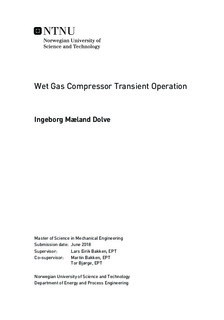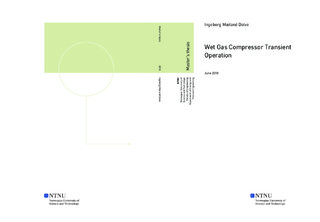| dc.description.abstract | Over the past years, the oil and gas industry has directed its attention towards subsea wet gas compression. Previous research has demonstrated that the operation of subsea wet gas compressors represents challenges related to transient response at various inlet conditions. Experimental work has been conducted to study the effects of wet gas on compressor aerodynamic and mechanical performance, which has presented many challenges in quantifying the effect of liquid presence on the compressor performance.
To date, the wet gas research has focused on the compressor and little attention has been given to the control valves surrounding the compressor. Control valves are an important part of the compression process, increasing the operational range and making the operation more flexible. Consequently, it is important to consider the effects of wet gas on the control valves. This thesis evaluates the performance of a centrifugal compressor and its discharge control valve at both wet and dry condition. The main objective of this thesis is to document the control valve performance at different gas mass fractions. Previous research on the wet gas compressor is presented, but the experimental campaign focuses on investigating valve wet gas performance.
No standard performance analysis for wet gas throttling through control valves exists. Thus, various methods are used in the industry. The valve performance calculation procedure used in this thesis is the Addition method. An experimental campaign was conducted in the NTNU wet gas compression test facility. Two different experimental set-ups were used to document the control valve performance. Water was injected either upstream or downstream of the compressor. The volume flow through the system was varied by altering the control valve opening. The gas mass fraction was varied from 1 to 0.8. Dry gas experiments were conducted to compare data from the valve manufacturer and the wet gas tests.
The results demonstrated that liquid properties influenced the control valve and compressor performance. A reduced volume flow and an increased pressure differential were observed for each valve opening when liquid was introduced. This indicated an increased throttling effect due to liquid blockage. The valve flow coefficient was reduced and a shift towards a linear valve characteristic was observed when the gas mass fraction was reduced. Additionally, a shift in operational point and system resistance curve was observed when liquid was introduced. The results in this thesis confirm the need for improved understanding of wet gas control valve throttling. | |

